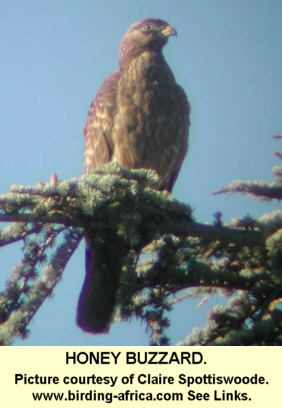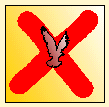
HONEY BUZZARD. Pernis
apivorus
IDENTIFICATION. The Honey Buzzard is not a true buzzard (Buteo). Similar in appearance and size to the Common Buzzard it has broad wings and finger like feathering at the tips. The head is small and 'pigeon' like, the body slim and the tail long with 2 bars at the base and one on the tip. Plumage is light with dark barring under the wings and has the added bonus of being a bristly barrier against wasp and bee stings.
Often mistaken for other buzzards
IN FLIGHT. Compared with the Common Buzzards shallow V and the flat wings of the Rough-legged Buzzard, the Honey Buzzards flight can be distinguished by its characteristic drooped wings. When displaying to a potential mate the wings are flapped above the body in what is known as the Honey Buzzards 'butterfly' like flight.
DISTRIBUTION. A summer visitor to the South of England, wintering in Europe, Africa and Asia. Preferred habitat is thick woodland.
WHEN SEEN. A summer visitor.
FOOD. Wasps, Bees and their grubs. Also small mammals and bird eggs.
BREEDING. May. 1 to 3 eggs laid in abandoned tree nests. Young hatch after 4-5 weeks, flying 40-45 days later.
SIZE. 51-58cm (20-23in)
WINGSPAN. 152cm (60in)
CALL. piha
FALCONRY.
A good bird to have if you are looking for something sweet to put on your toast in the morning! Not generally used in falconry.
NB. If you buy one of these raptors it should be fitted with a closed leg ring and have an Article 10 form with it (any queries check with DEFRA).
Falconry marks
